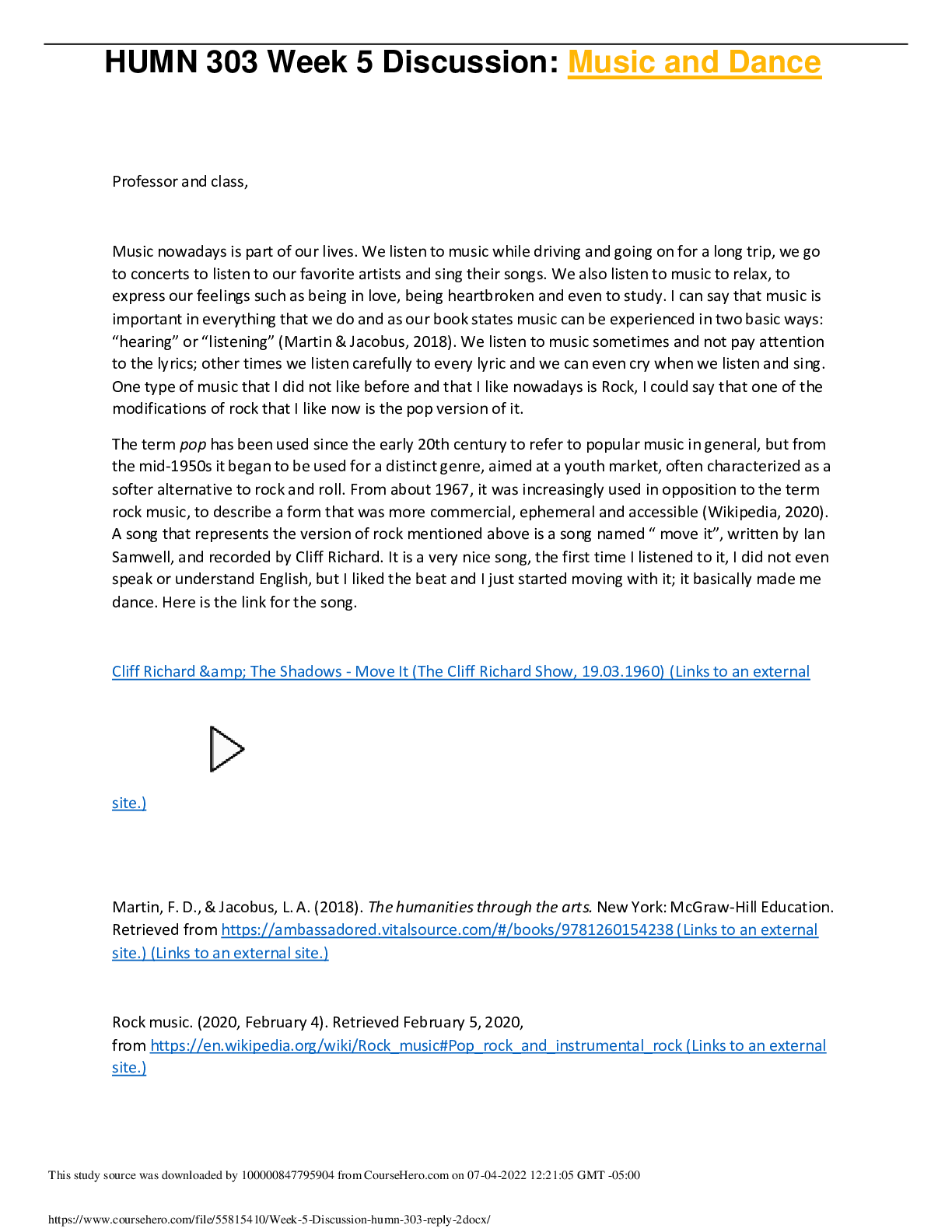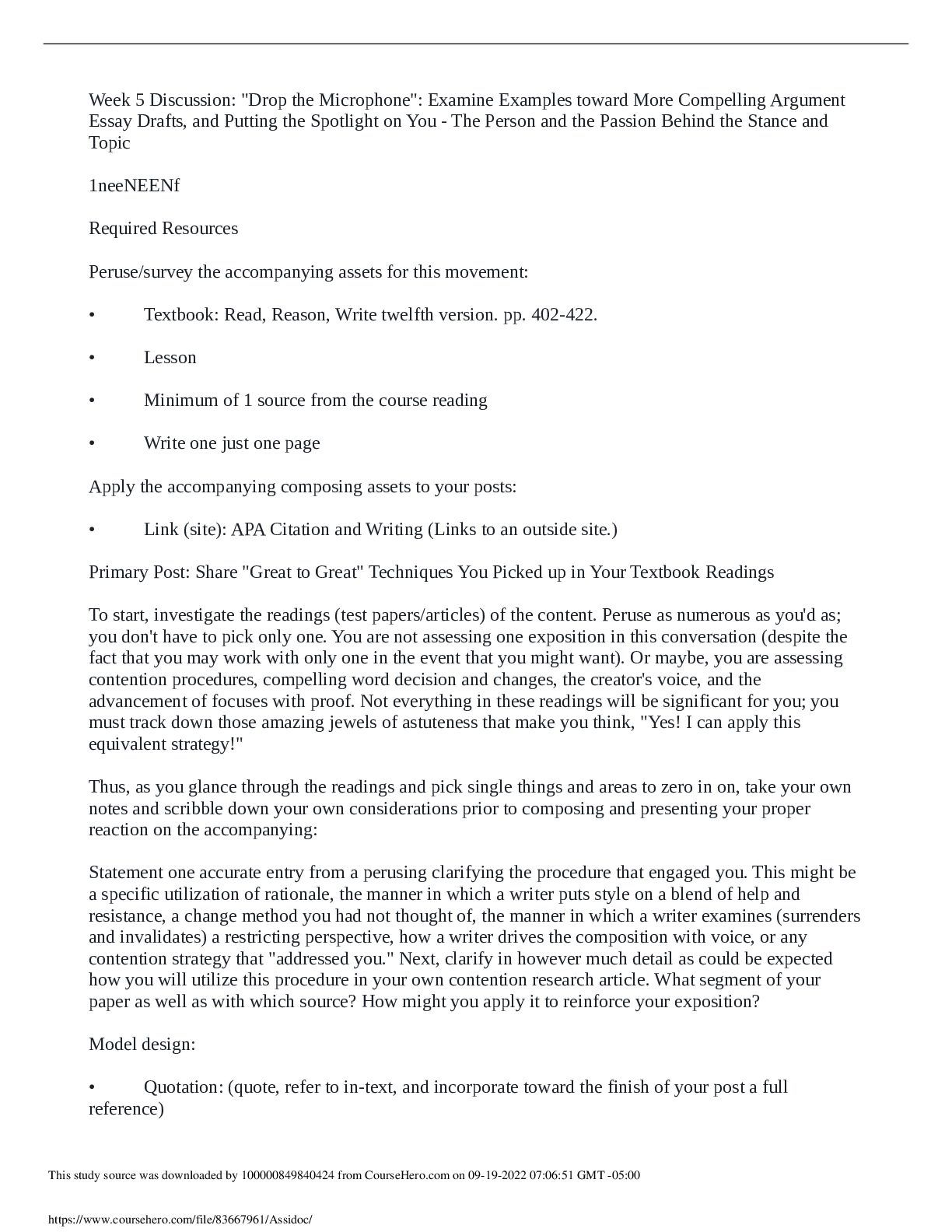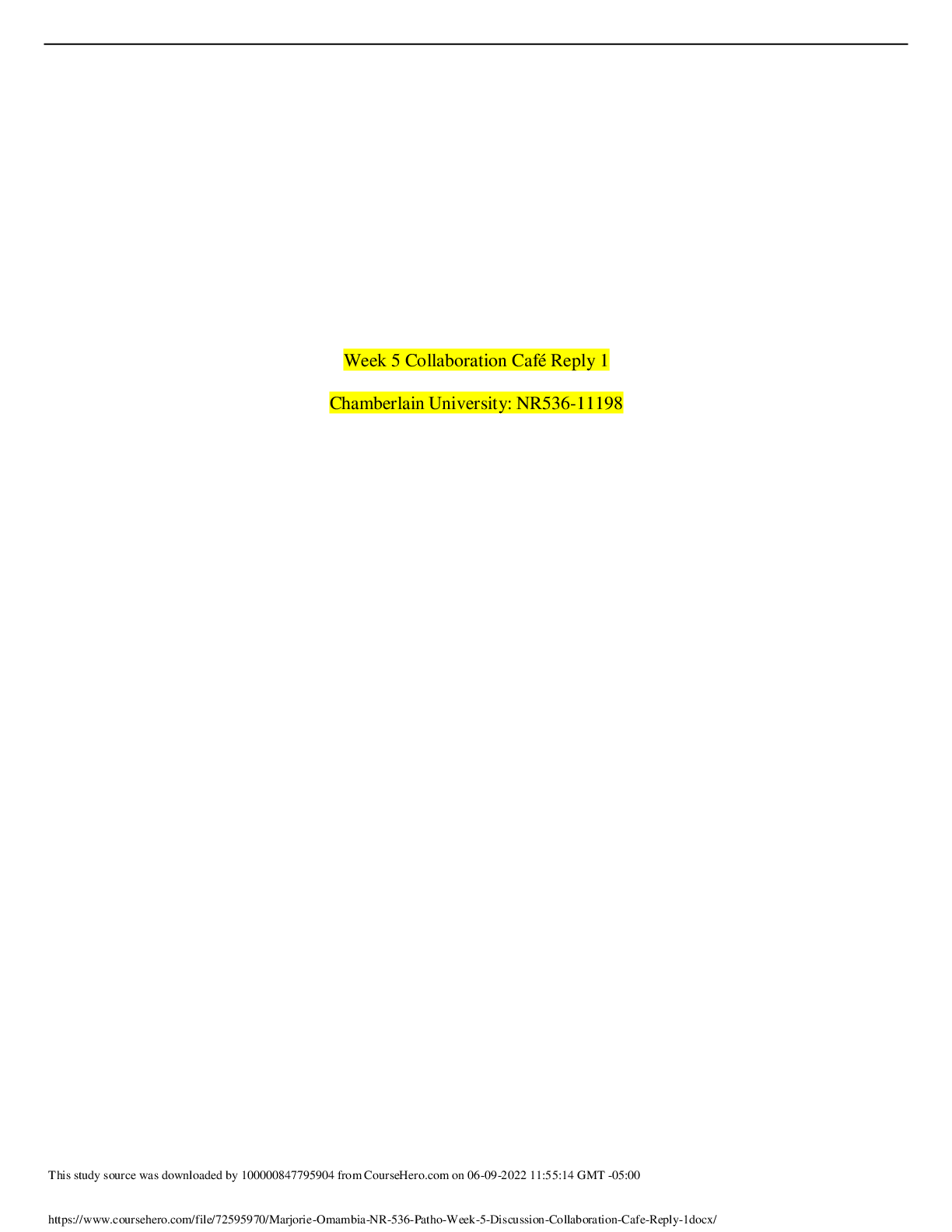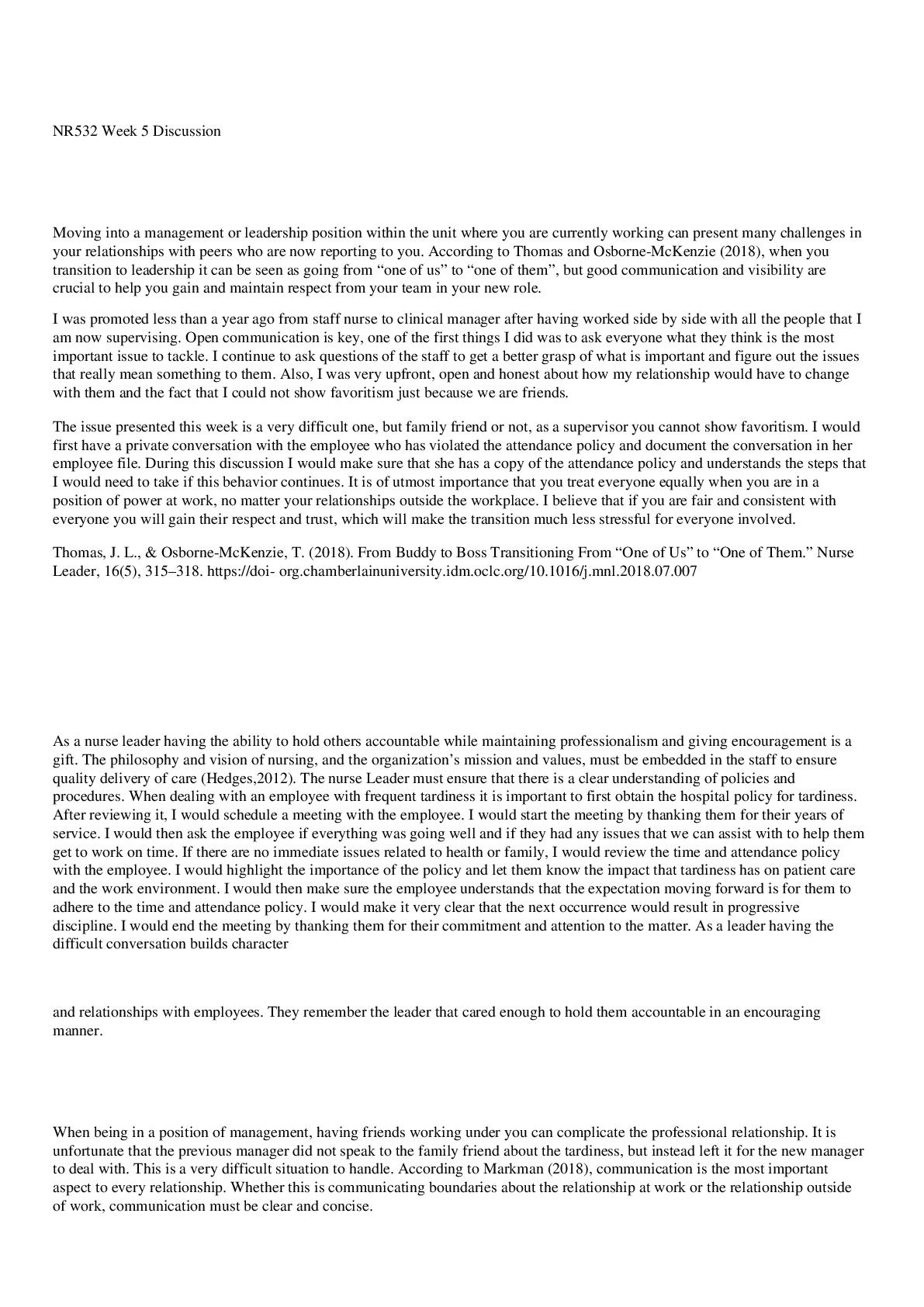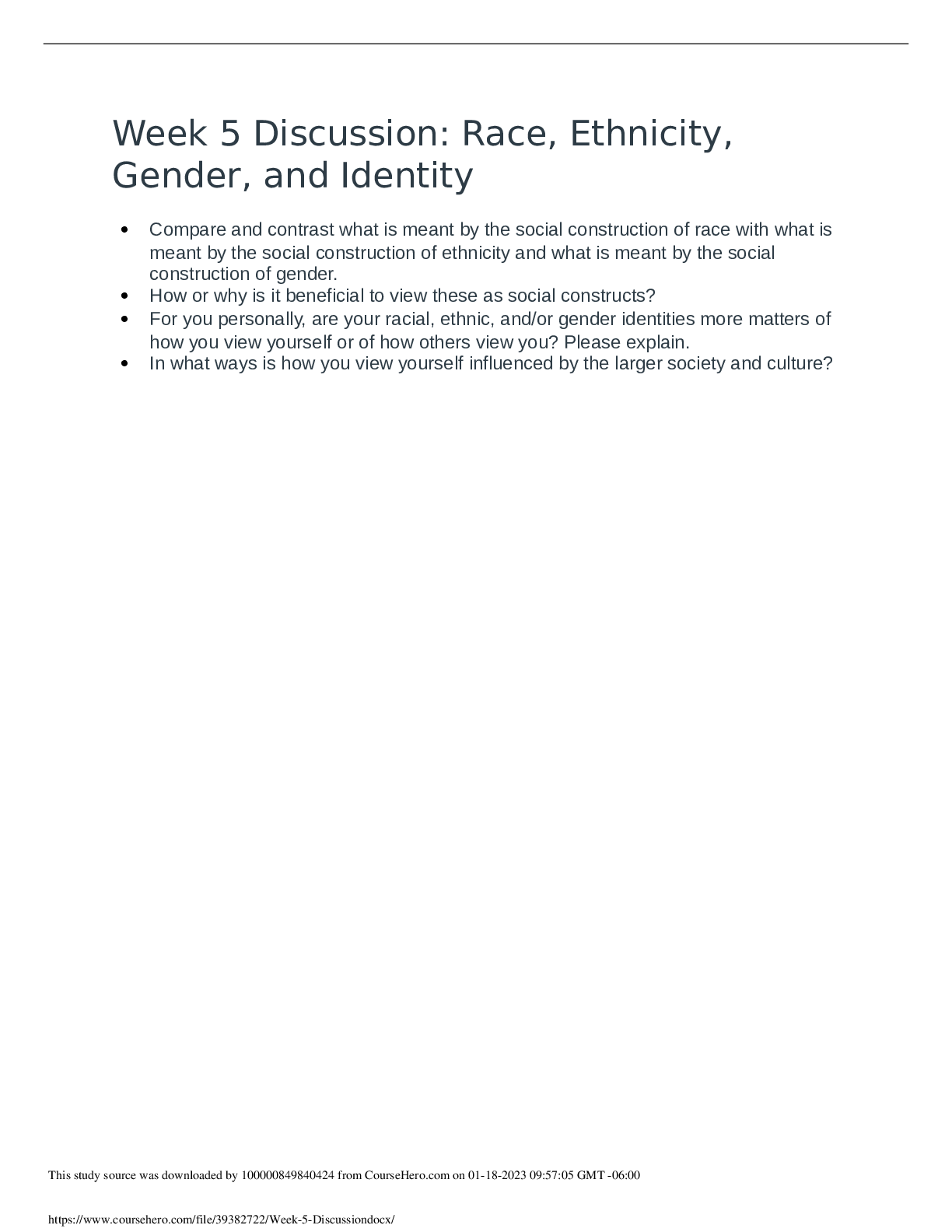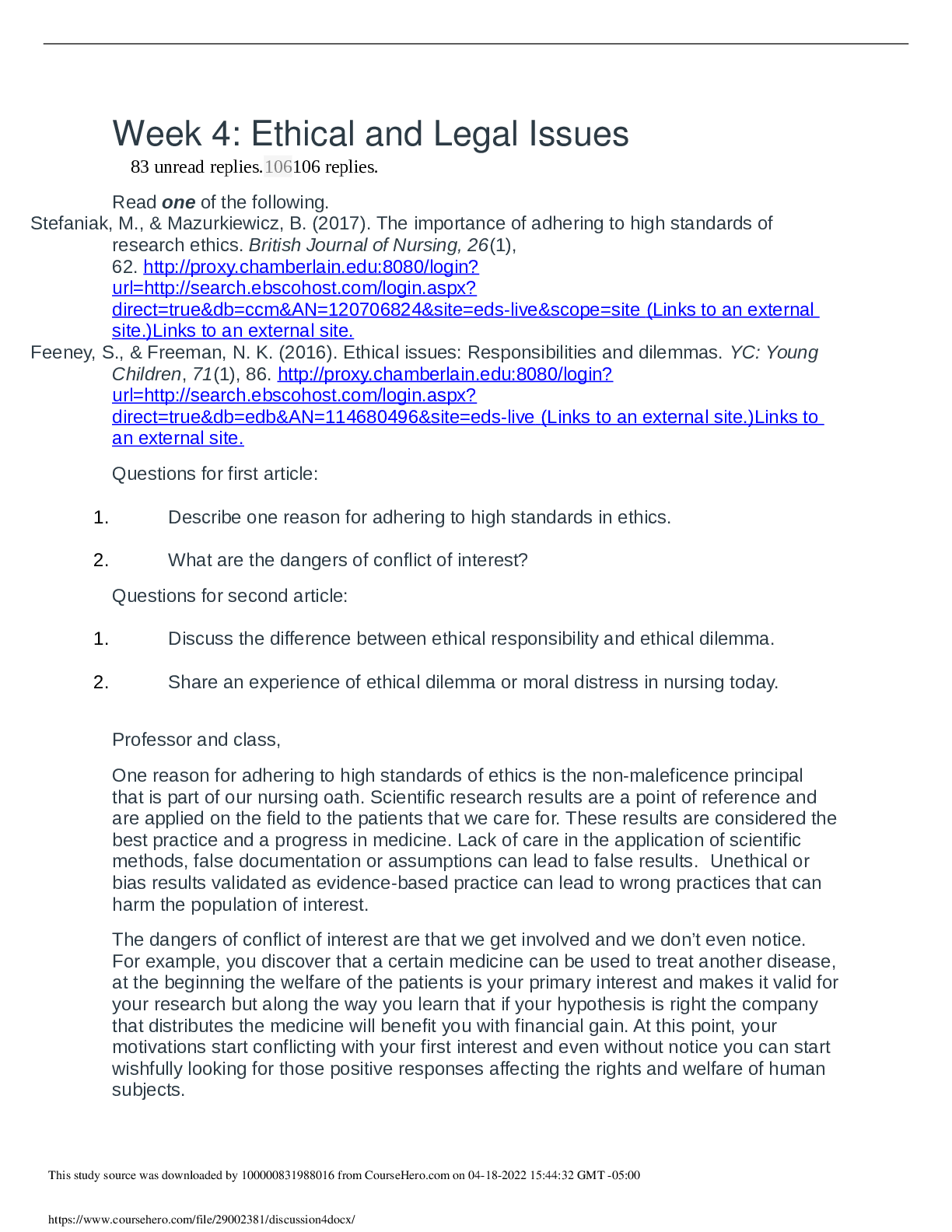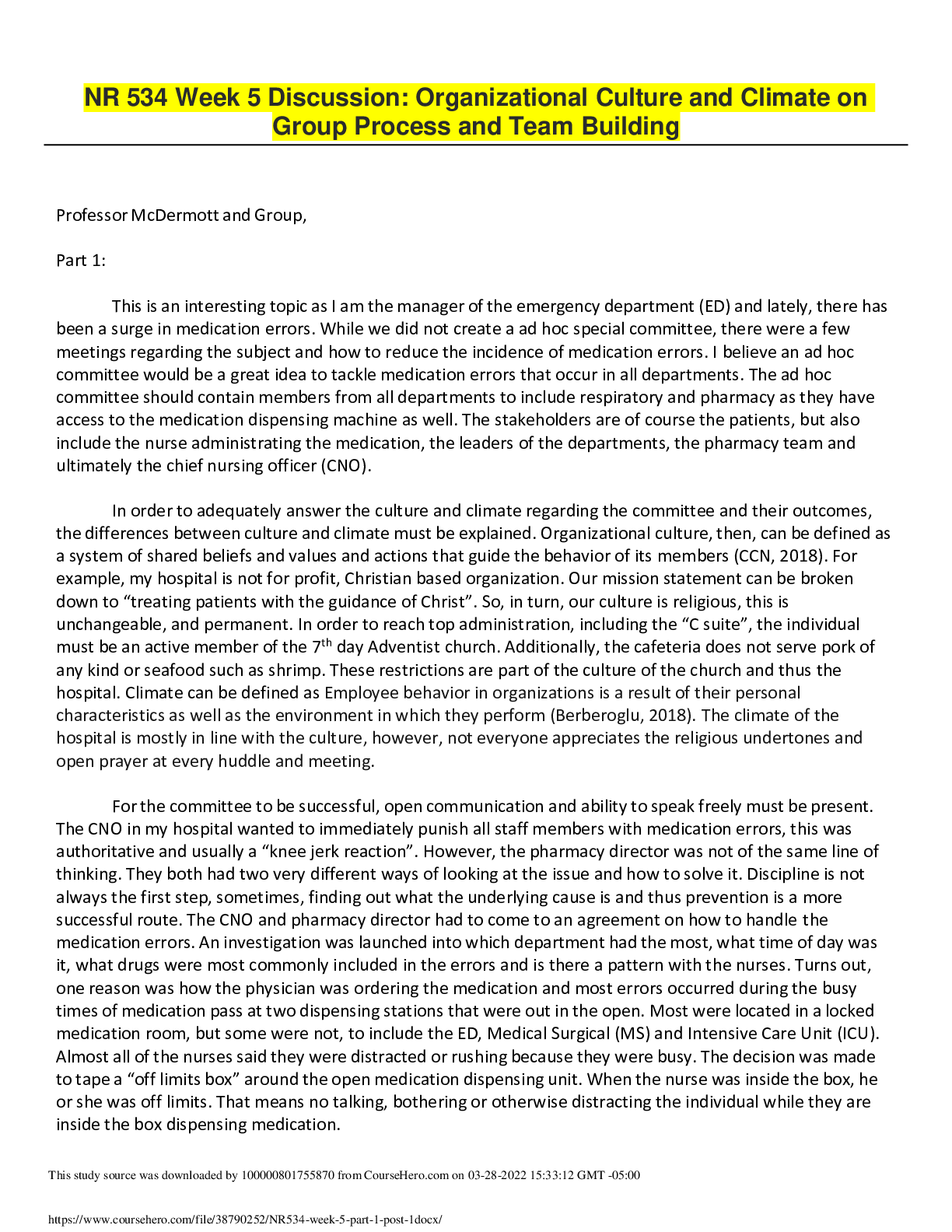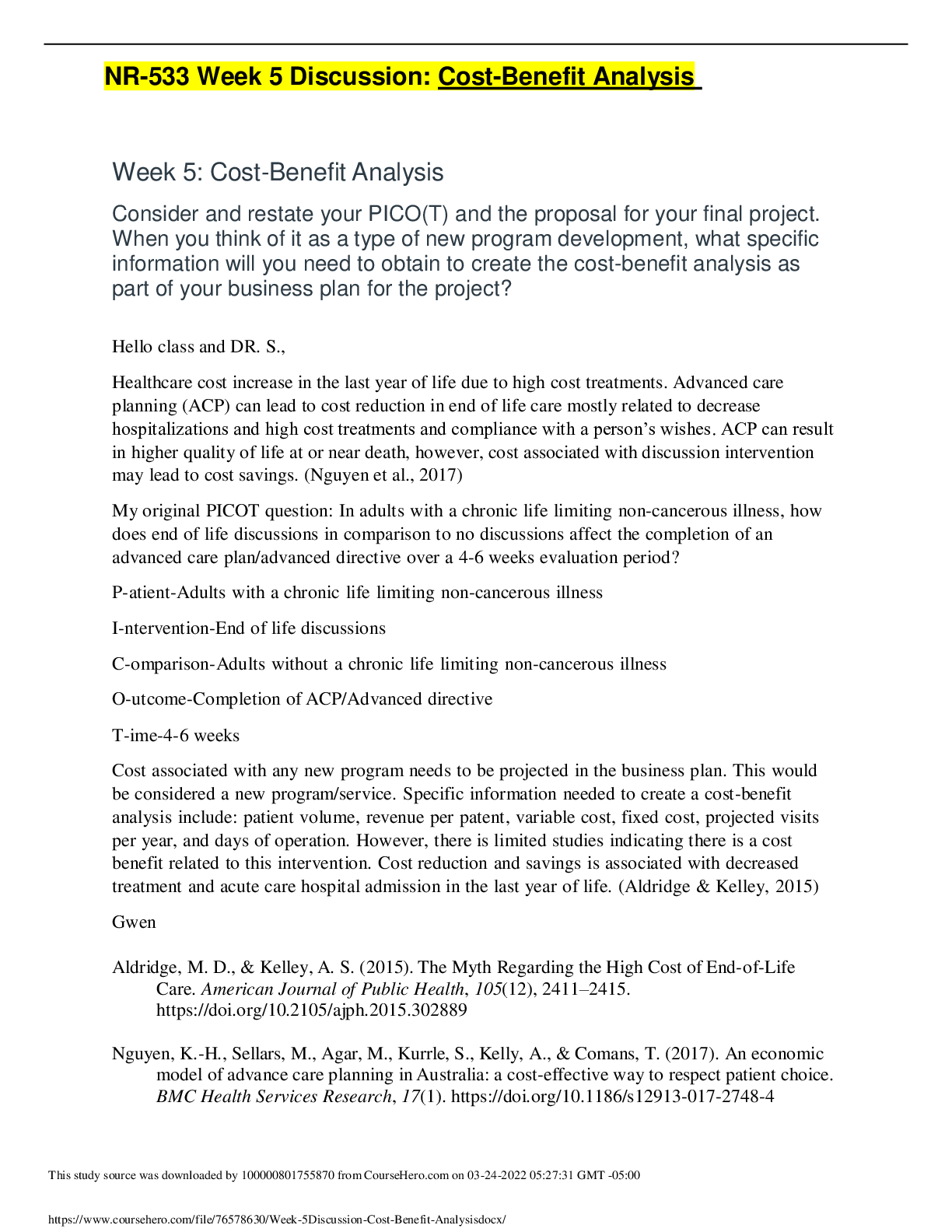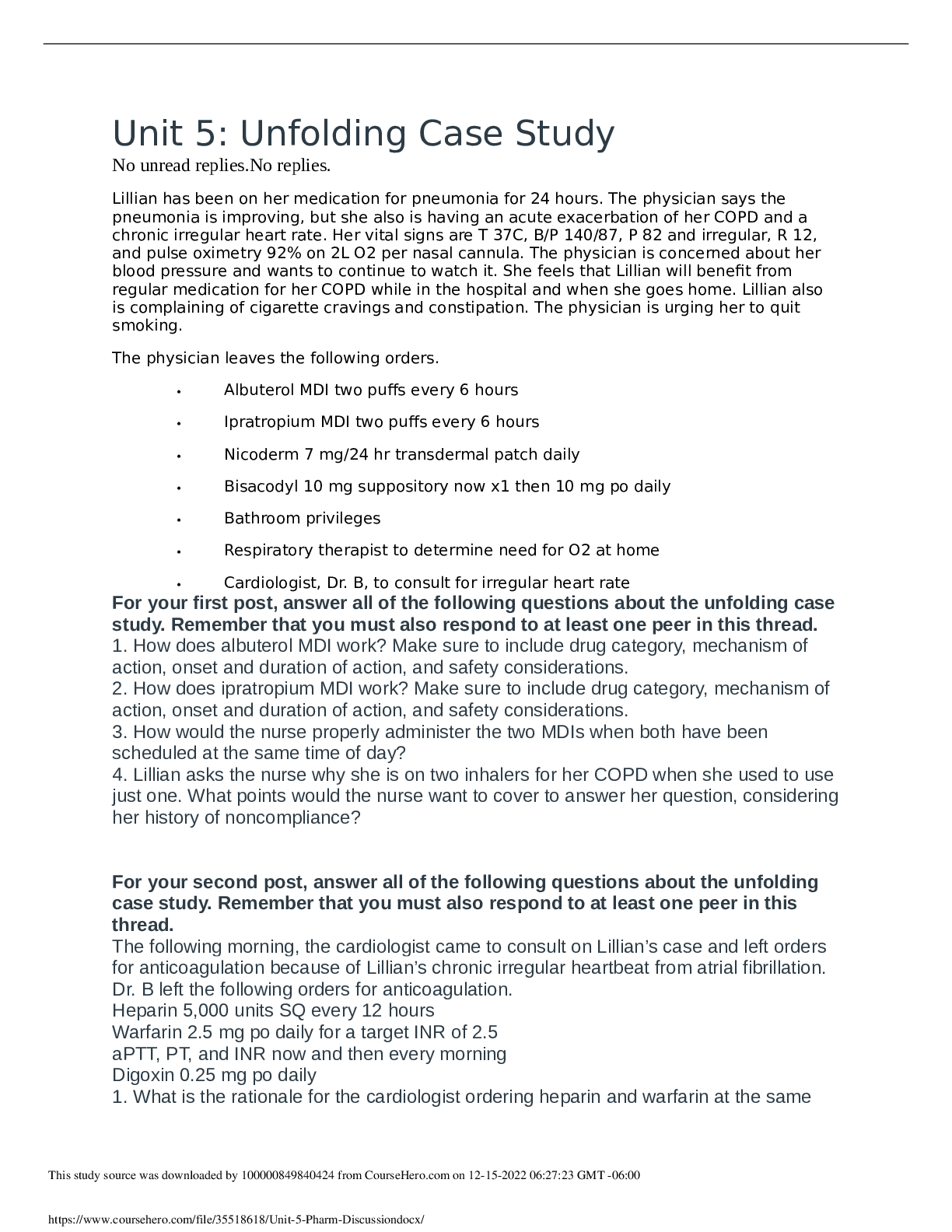*NURSING > DISCUSSION POST > NR 506 Week 5 Discussion: Ethical and Legal Implications (LATEST UPDATE) (All)
NR 506 Week 5 Discussion: Ethical and Legal Implications (LATEST UPDATE)
Document Content and Description Below
NR 506 Week 5 Discussion: Ethical and Legal Implications Decision Making in Nursing Practice: A Concept Analysis Week 5: Ethical and Legal Implications You are a family nurse practitioner w... orking in an outpatient primary care office of a large hospital system. The practice has been operating for over 15 years, and many of the administrative and clinical staff were hired when the practice opened. You have been in the practice for less than 3 months. In that short amount of time, you have witnessed several of the clinical staff engaging in heated arguments with each other, sometimes in the patient areas. You overhear an argument occurring today between two staff. You pick up a patient's chart and notice a very low blood pressure that the medical assistant failed to notify you about. When you confront the MA, she states that she was going to report the vital signs to you when she became engaged in the heated argument you overheard and forgot to notify you. Unfortunately, this pattern of behavior is not unusual in this practice. Working with staff who cannot cooperate effectively can negatively influence your ability to spend time with patients, can impede the flow of patients through the office, and could impact patient safety. Week 5: Ethical and Legal Implications Case Study Responses: 1. Analyze the case study for potential issues for members of the healthcare team from office conflict. Contrast the potential effects for each member of the healthcare team based upon the required readings from the week. Discuss the potential ethical and legal implications for each of the following practice members: Conflict will always be part of the workplace environment. Nobody likes addressing conflict, but it’s sometime that needs to be done in a timely matter to void legal and ethical dilemma If the conflict is not address in a timely matter and allowed to continue it will negatively affect workplace environment, patients and patient outcome. Every members of the healthcare team is responsible for their own action and must act in professional manner regardless of the conflict. The highest priority in the clinical setting is patient safety and its everyone is responsible. ➢ Medical assistant (MA): The (MA) failed the ethical principles of beneficence, the duty to do good to others and maintain a balance between benefits and harms. The (MA) failed to notify the (NP) of the patient’s low blood pressure because a conflict that arose; therefore, potentially impacting patient safety. The (MA) allowed the conflict to interfere with their responsible and only placing the patient in potential harm but also placing the practice into potential law sue in the form of negligent or malpractice depending on the patient outcome. ➢ Nurse Practitioner (NP): Even though the (NP) was not the person who failed to report the low blood pressure, he/she is ultimately responsibility for the patient care. This situation placed the (NP) in an ethical and legal dilemma. The (NP) failed the ethical principles of beneficence, because he/she has now been working at this practice for about 3 moths and in this short time he/she has witnessed several of the clinical staff engaging in heated arguments with each other, sometimes in the patient areas. The case study does not state if the (NP) has addressed the issues before or not, but allowing it to continue places the (NP) at risk for a lawsuit due to negligent or malpractice depending on the patient outcome ➢ Medical Director: The Medical Director is ultimately responsibility ethical and legally for everyone in the practice including patients. The medical director has failed the ethical principles of nonmaleficence, beneficence and justice. She/he has an obligation to do or cause no harm to others, by allowing the conflict among staff to continue has negatively influence the ability of the (NP) to spend time with patients, impede the flow of patients through the office, and impact patient safety. The practice itself is at risk for potential lawsuit due to negligent or malpractice. ➢ Practice: The practice needs teamwork in order to succeed. Teamwork is identified as a key element for ethical practice, providing quality care, patient safety and outcomes (Hamid,2016). The practice could have been charge with malpractice due to the delayed in diagnosis and treatment of the low blood pressure. The practice could also be responsible for negligence of the employees. 2. What strategies would you implement to prevent further episodes of potentially dangerous patient outcomes? The following steps will be implemented in order to prevent further episodes of unprofessional behavior, resulting in potentially dangerous patient outcome. Step 1: Identify the causes of the of the specific problem (AHRQ, 2019): In order to resolve a conflict, we must find out what the problem is about and what is the root cause of the problem. By identifying the causes of conflict, we can work together to work on possible solution. Step 2: Promote communication We must educate clinical staff on the effective communication. Heated arguments specially in the patient areas is not acceptable behavior or communication. To ensure appropriate communication, we must identify the barriers affect communication. We will encourage an open environment to speak with each-other is a respectful manner. The rules and expectations will be educated to all staff. Research has demonstrated that effective communication and teamwork promotes patient safety (Gluyas, 2015). Step 3: Promote Teamwork Everyone staff members will be recognized as part of the team and will be treated with respected. Research evidence has suggested that effective teamwork can significantly increase quality of care, patient safety, reduce workload, reduce stress among staff, increase job satisfaction and retention (Kumar, 2014). Step 4: Teach conflict resolution skills. We will promote commination and expressing feeling in a clam and professional manner. Achieving proper conflict resolution skills can increase effectiveness, promote trust and openness. Everyone will be given time to speak, while others listen. All conflict among staff will be address in a timely manner. Allowing unresolved conflict can result in violence, opening a window to a hostile work environment (Kumar, 2014). 3. What leadership qualities would you apply to effect positive change in the practice? Focus on the culture of the practice. I see myself as a transformational leader. The leadership qualities, I would apply to effect positive change would be building a trusting, supporting and open communication. I would encourage, inspire and motivate others to promote change. A leadership is a person that holds the power to influence or change the beliefs, values, behaviors and attitudes of others (Ganta, and Manukonda, 2014). A leader with strong leadership skills can easily motivate and influences employees to promote change within the organization (Atkinson, 2015). I will ensure that everyone share in the vision of change and empower them to support positive change in order to foster patient safety, quality care and outcomes References Agency for Healthcare Research and Quality. Section 4. Identifying Strategies. October 1, 2019. Retrieved from: hhtps://www.ahrq.gov/research/findings/final-report/ptflow/section4.html Atkinson, P., & Mackenzie, R. (2015). Without leadership there is no change. Fischer, S. (2016). Transformational leadership in nursing: A concept analysis. Journal of Advanced Nursing, 72(11), 2644-2653. doi:10.1111/jan.13049 Ganta, V. C. and Manukonda, J. K. (2014). Leadership During Change and Uncertainty in Organizations. International Journal of Organizational Behavior & Management Perspectives, 3(3), 1183. Gluyas, H. (2015). Effective communication and teamwork promote patient safety. Nursing Hamid, S. (2016). Ethical issues faced by nurses during nursing practice in district Layyah, Pakistan. Diversity and Equality in Health Care. 13(4). 302-308. Kumar, S., Deshmukh, V., & Adhish, V. S. (2014). Building and leading teams. Indian journal of community medicine: official publication of Indian Association of Preventive & Social Medicine, 39(4), 208–213. doi:10.4103/0970-0218.143020 MA de Vries, J., & Curtis, E. (2019). Nursing leadership in ireland: Experiences and obstacles. Leadership in Health Services, 32(3), 348-363. doi:10.1108/LHS-11-2017-0068 Salas, E., Shuffler, M., Thayer, A., Bedwell, W., & Lazzara, E. (2015). Understanding and improving teamwork in organizations: A scientifically based practical guide. Human Resource Management, 54(4), 599-622. doi:10.1002/hrm.21628 Nurses were aware about their ethical responsibilities but were unable to practice them because of the multiple constraints. Ethical issues in the nursing practice attract little attention, resulting in the creation of moral distress, poor professional care, unproductivity and conflict. medical assistant failed to notify the nurse practitioner of a patient’s low blood pressure because a conflict arose; therefore, potentially impacting patient safety. Although conflict is an unavoidable characteristic of the workplace setting, the style with which the individual manages conflict is important to how it affects workers and patient outcomes (Johansen, 2014). According to Johansen (2014), to effectively and efficiently resolve a conflict, an individual must assess the nature of the conflict and choose the most appropriate management style for the situation at hand (Johansen, 2014). By managing conflicts in an effective and efficient manner results in improved quality patient care, patient safety and staff morale (Johansen, 2014). The impact of conflict, if not handled in an appropriate and timely fashion, not only threatens patient safety, but also the well-being of employees and their ability to perform their duties and responsibilities competently (Longo, 2010 Johansen, M., & O'Brien, J. (2016). Decision making in nursing practice: A concept analysis. Nursing Forum, 51(1), 40-48. doi:10.1111/nuf.12119 [Show More]
Last updated: 1 year ago
Preview 1 out of 5 pages
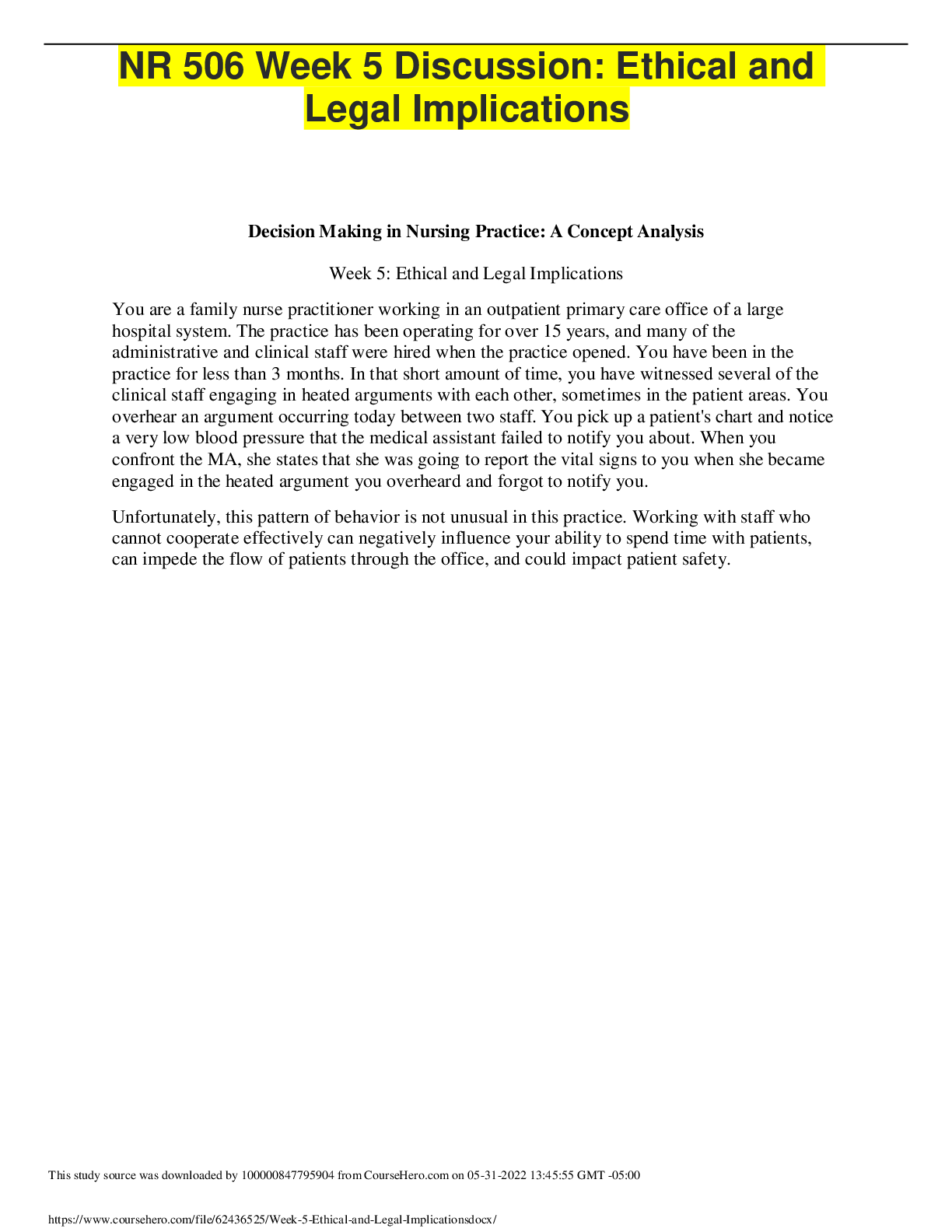
Reviews( 0 )
Document information
Connected school, study & course
About the document
Uploaded On
May 31, 2022
Number of pages
5
Written in
Additional information
This document has been written for:
Uploaded
May 31, 2022
Downloads
0
Views
105
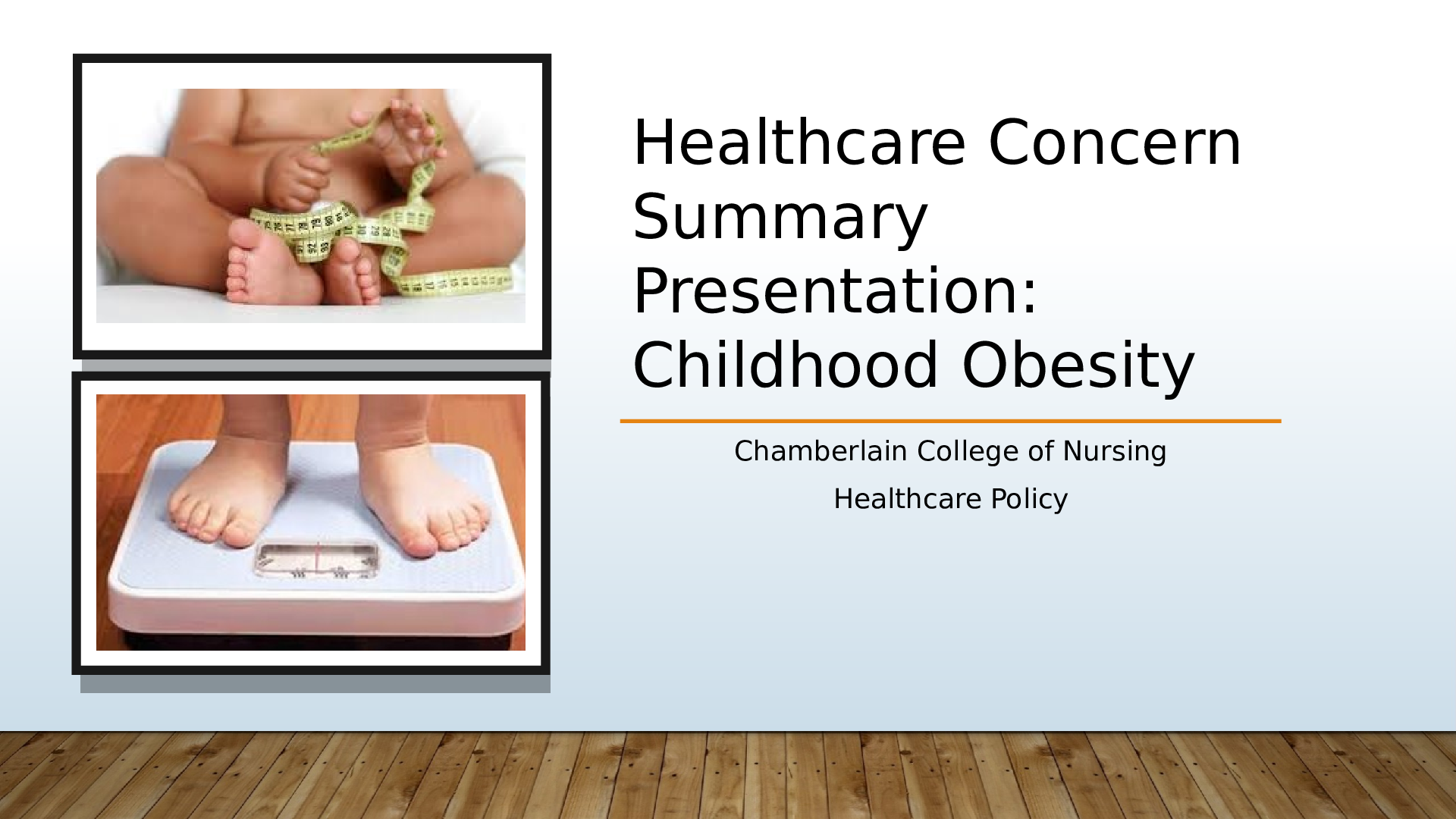

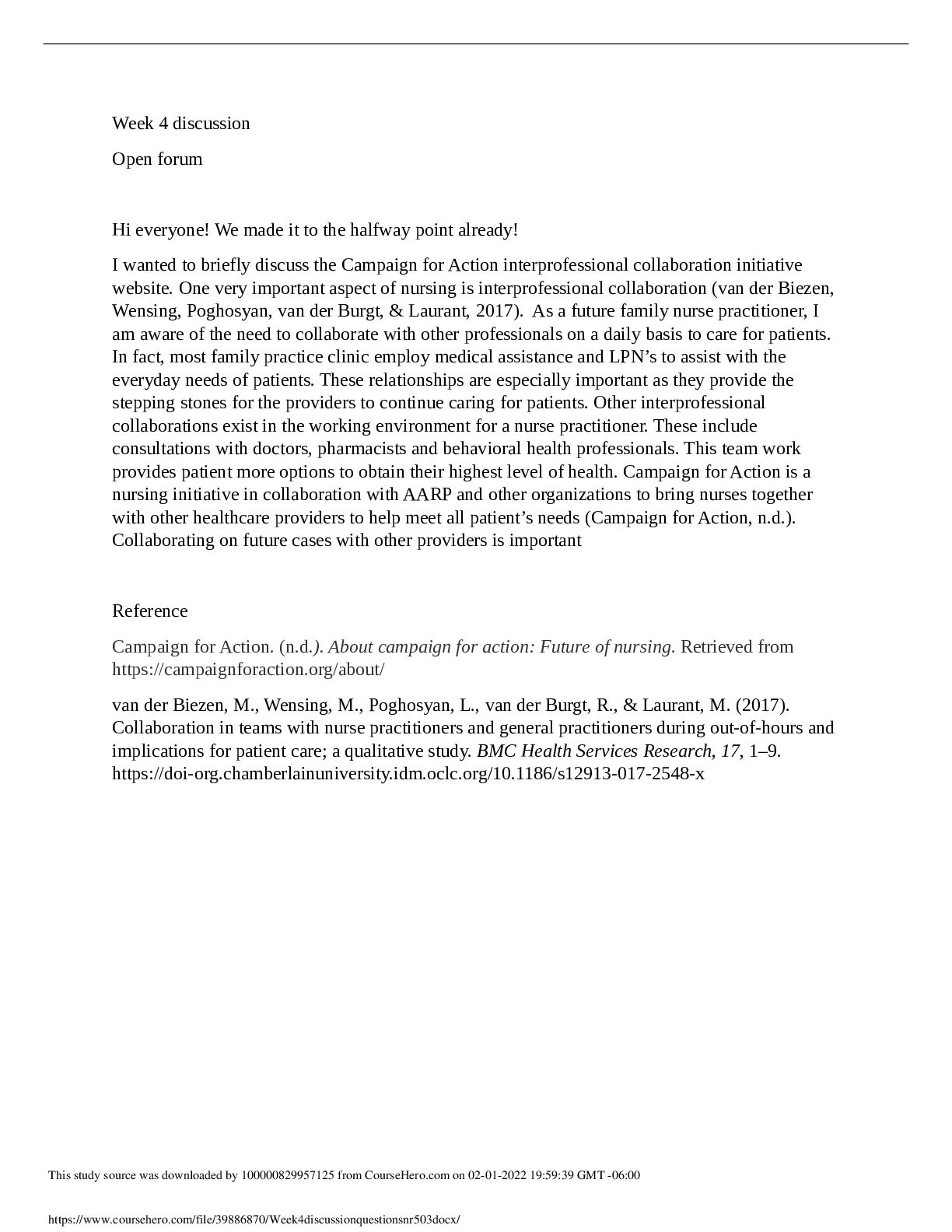
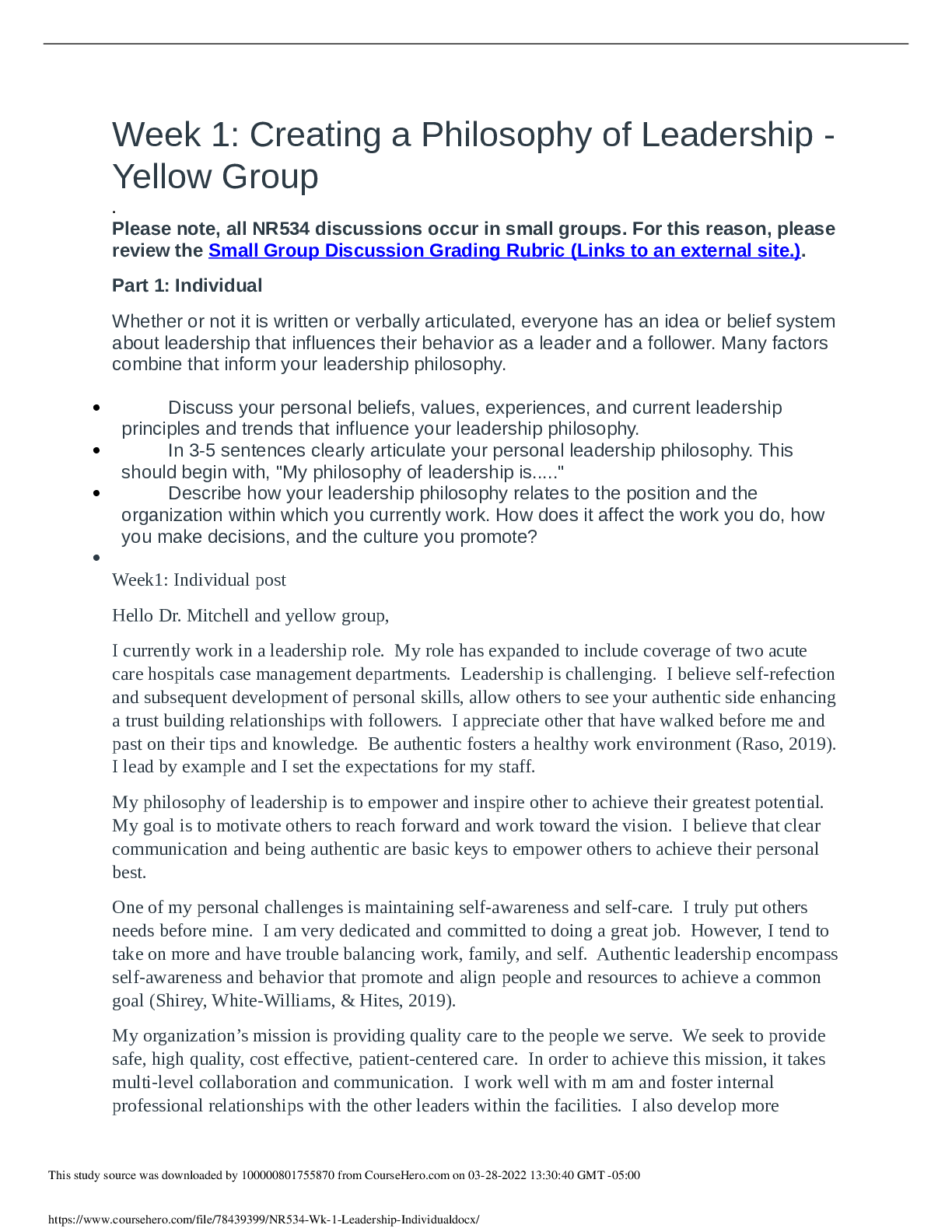
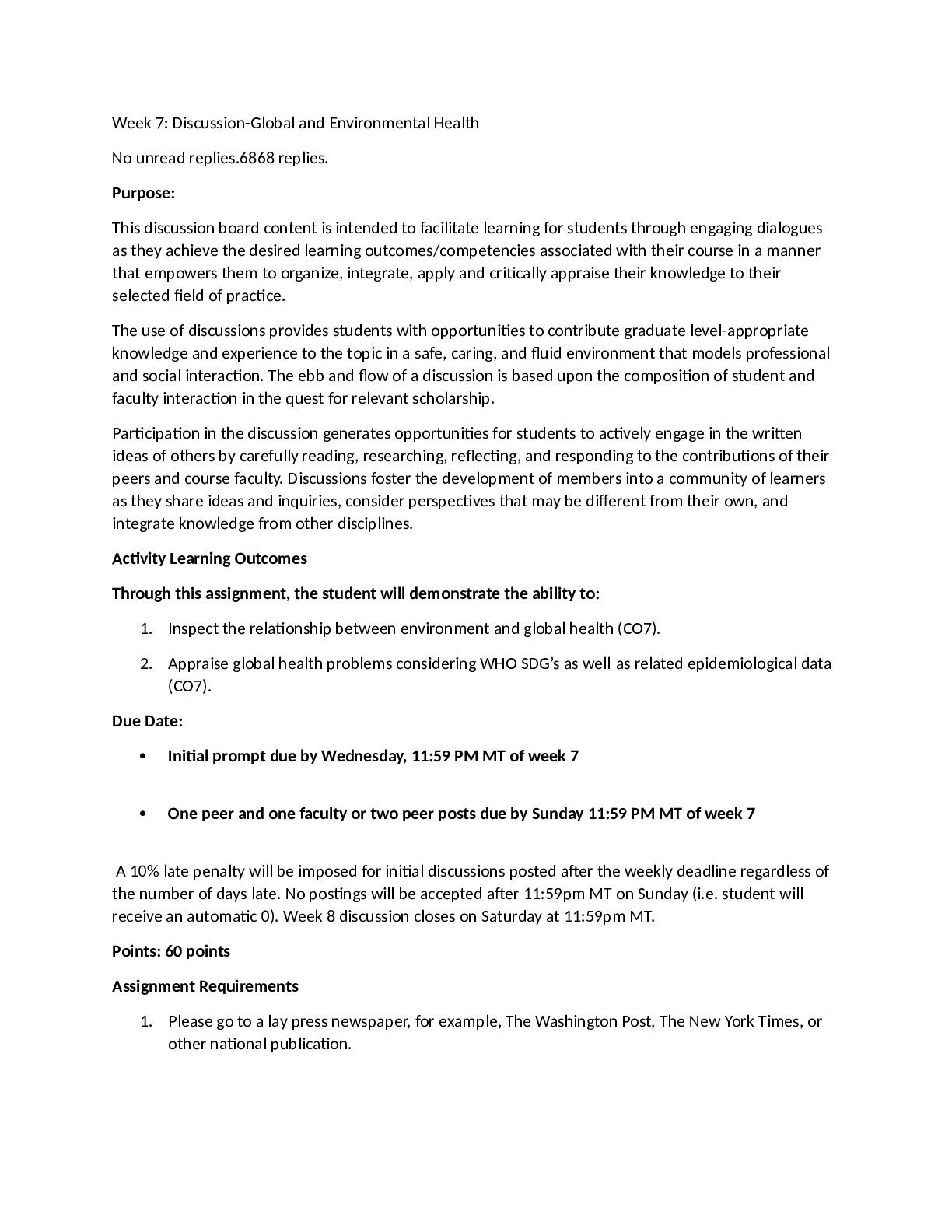


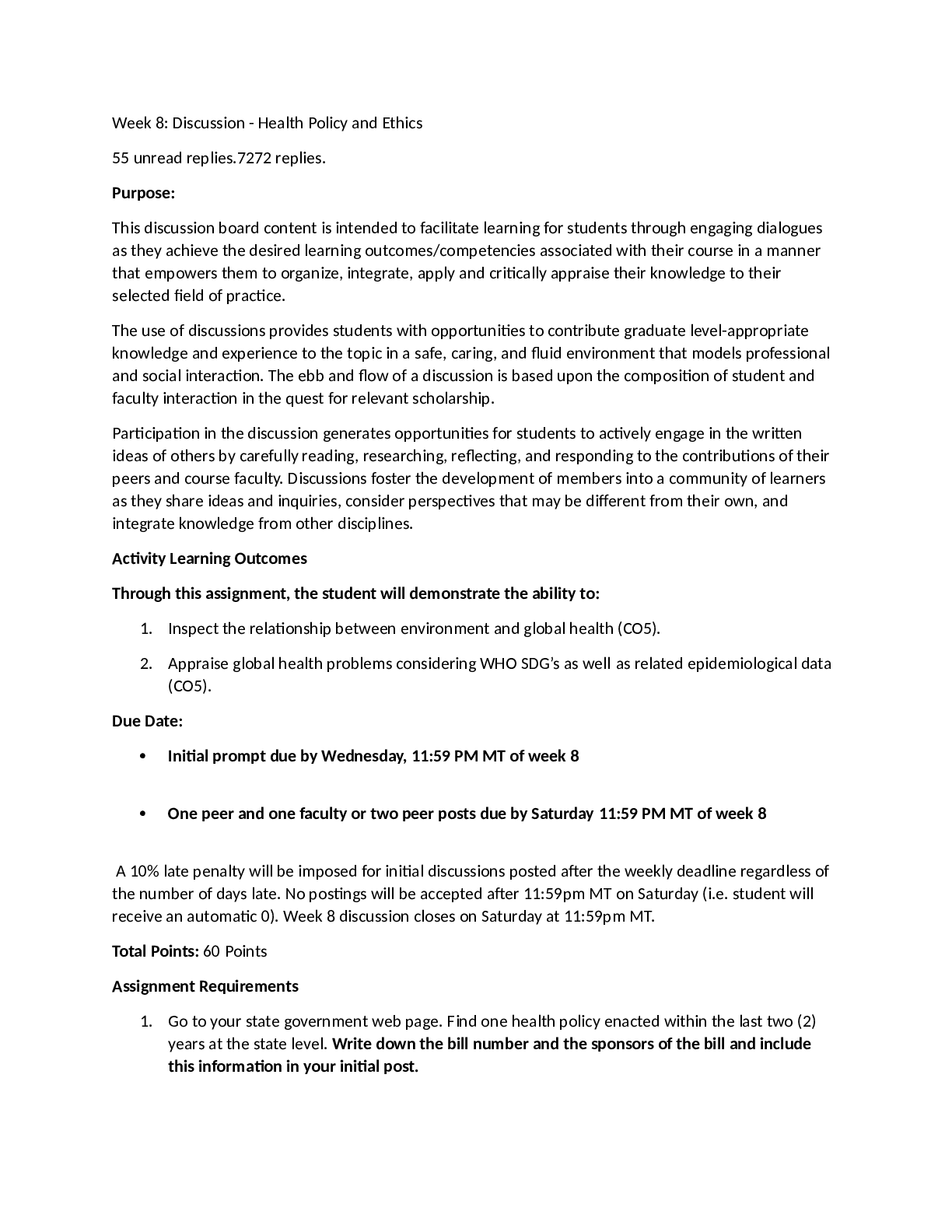
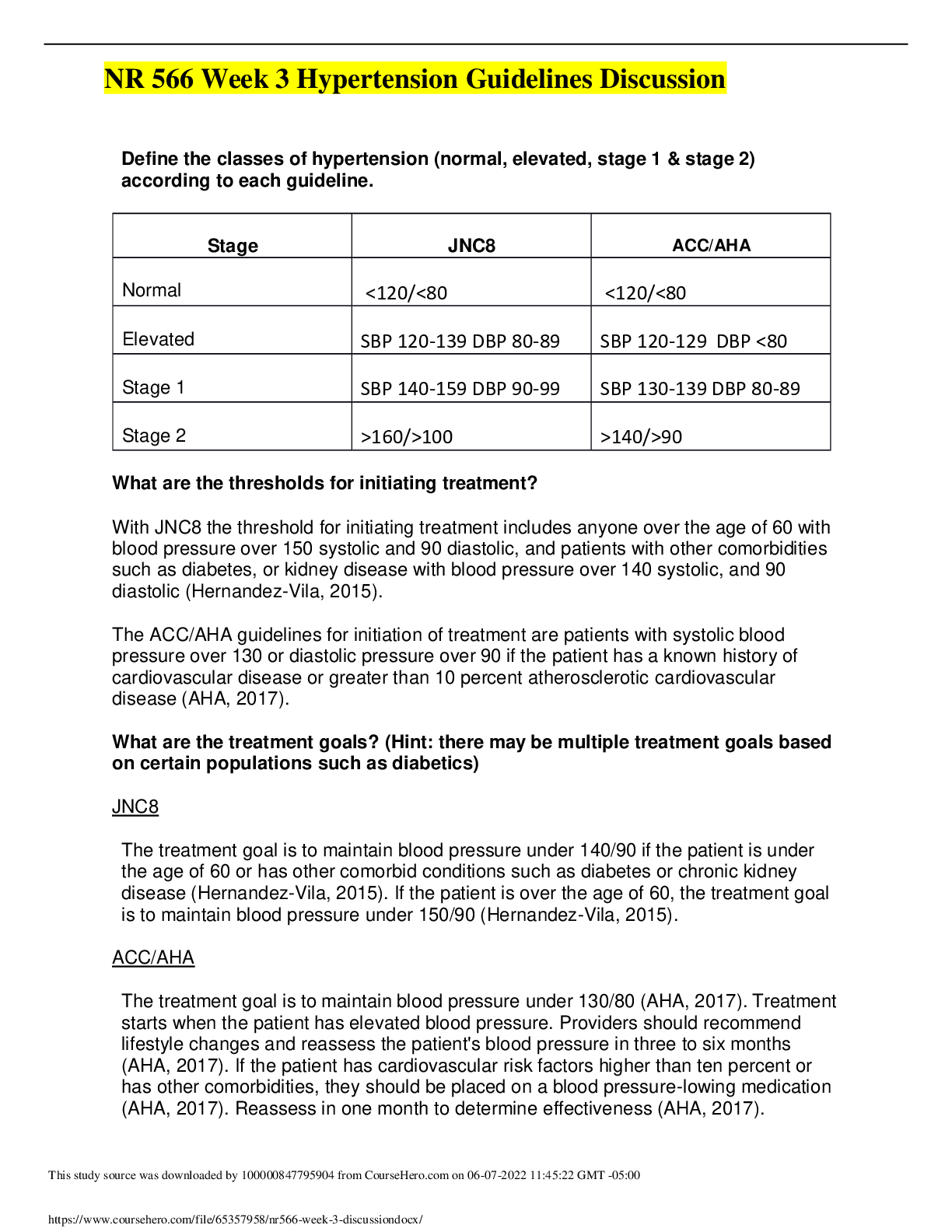
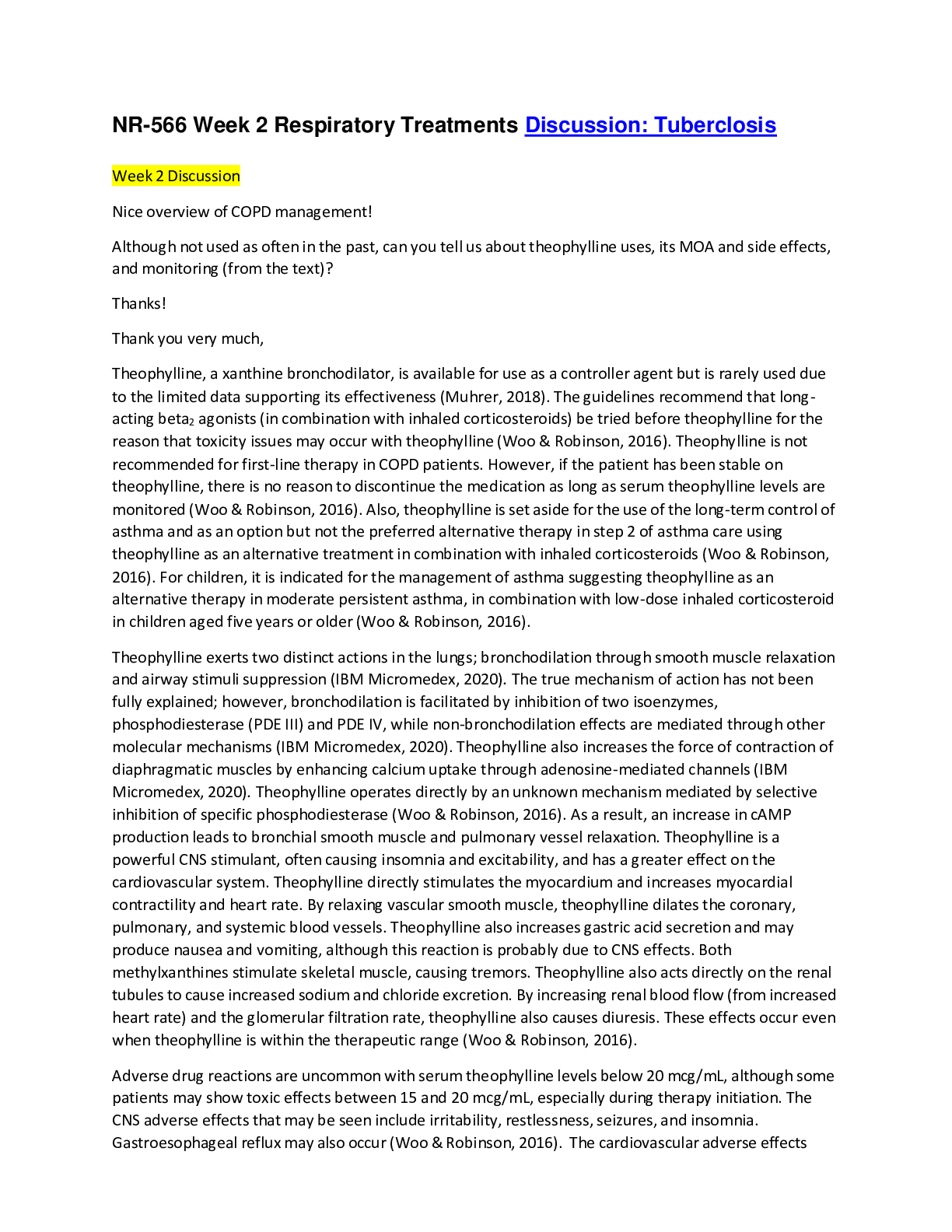
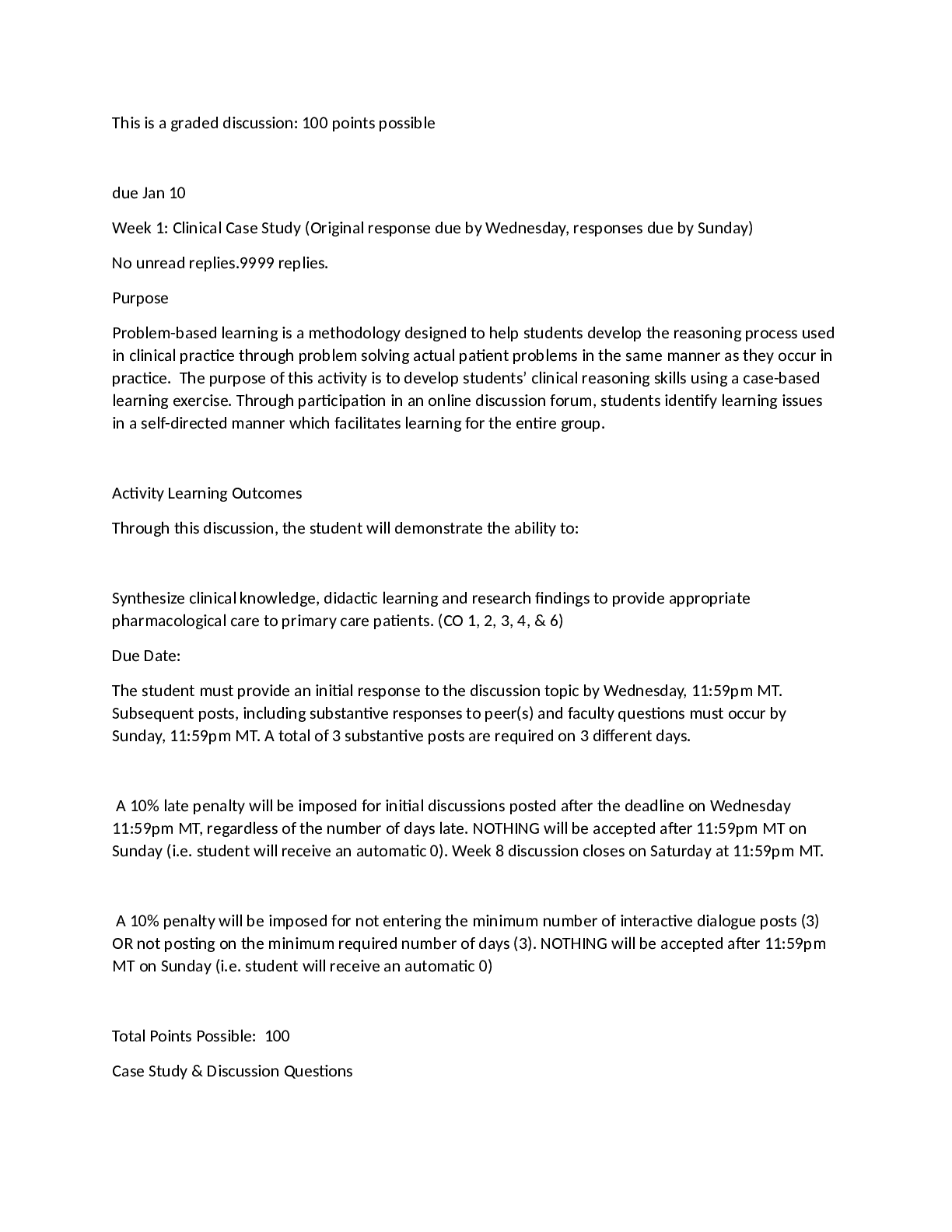
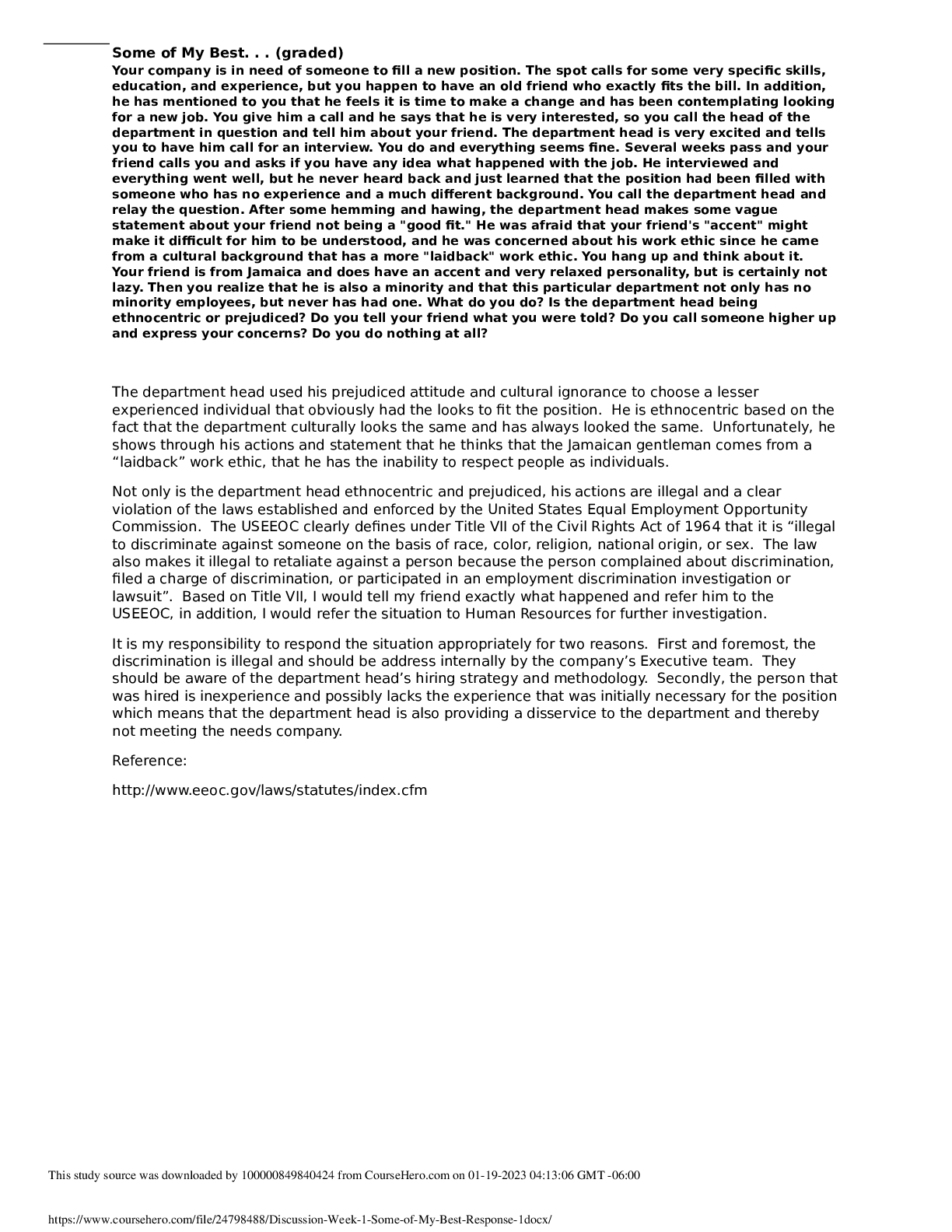


.png)
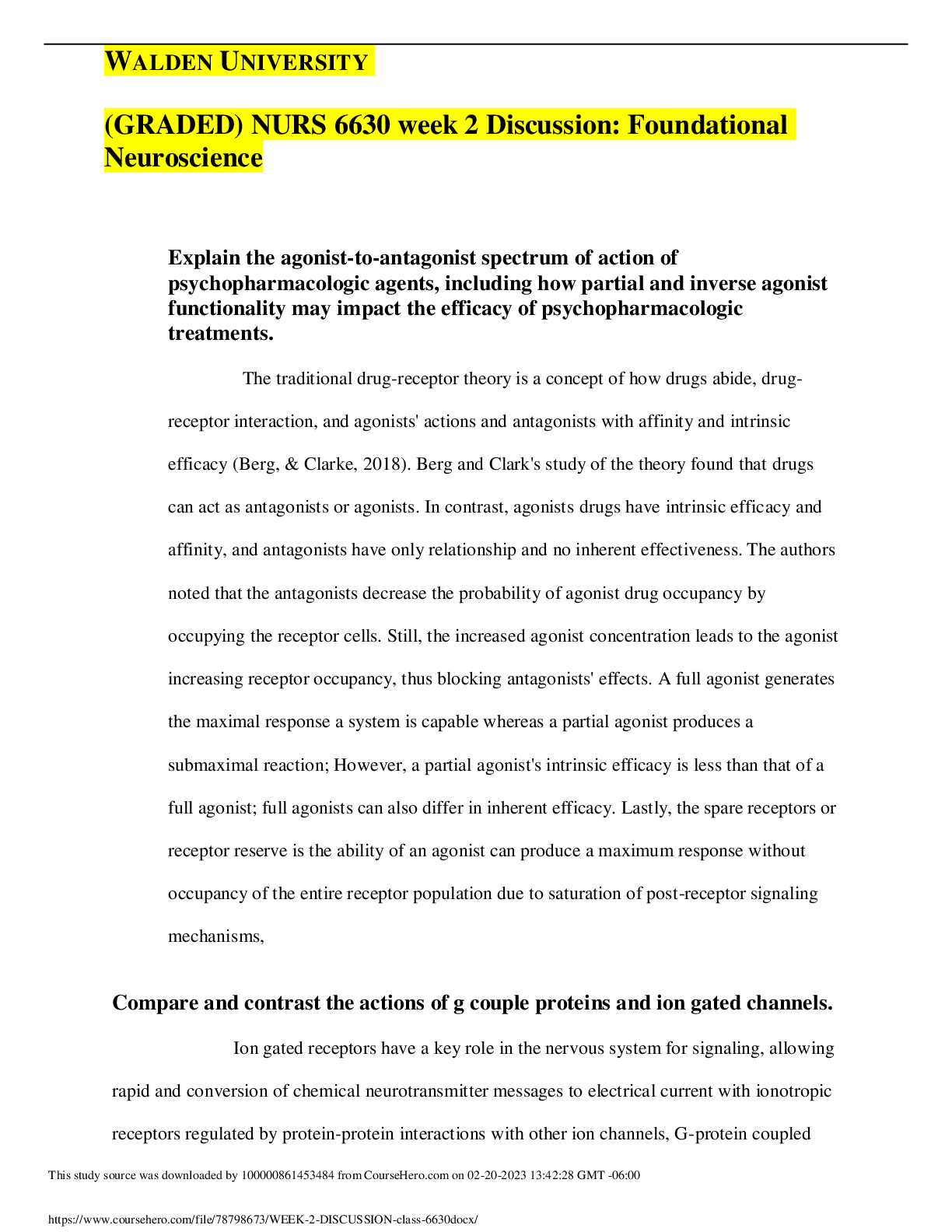

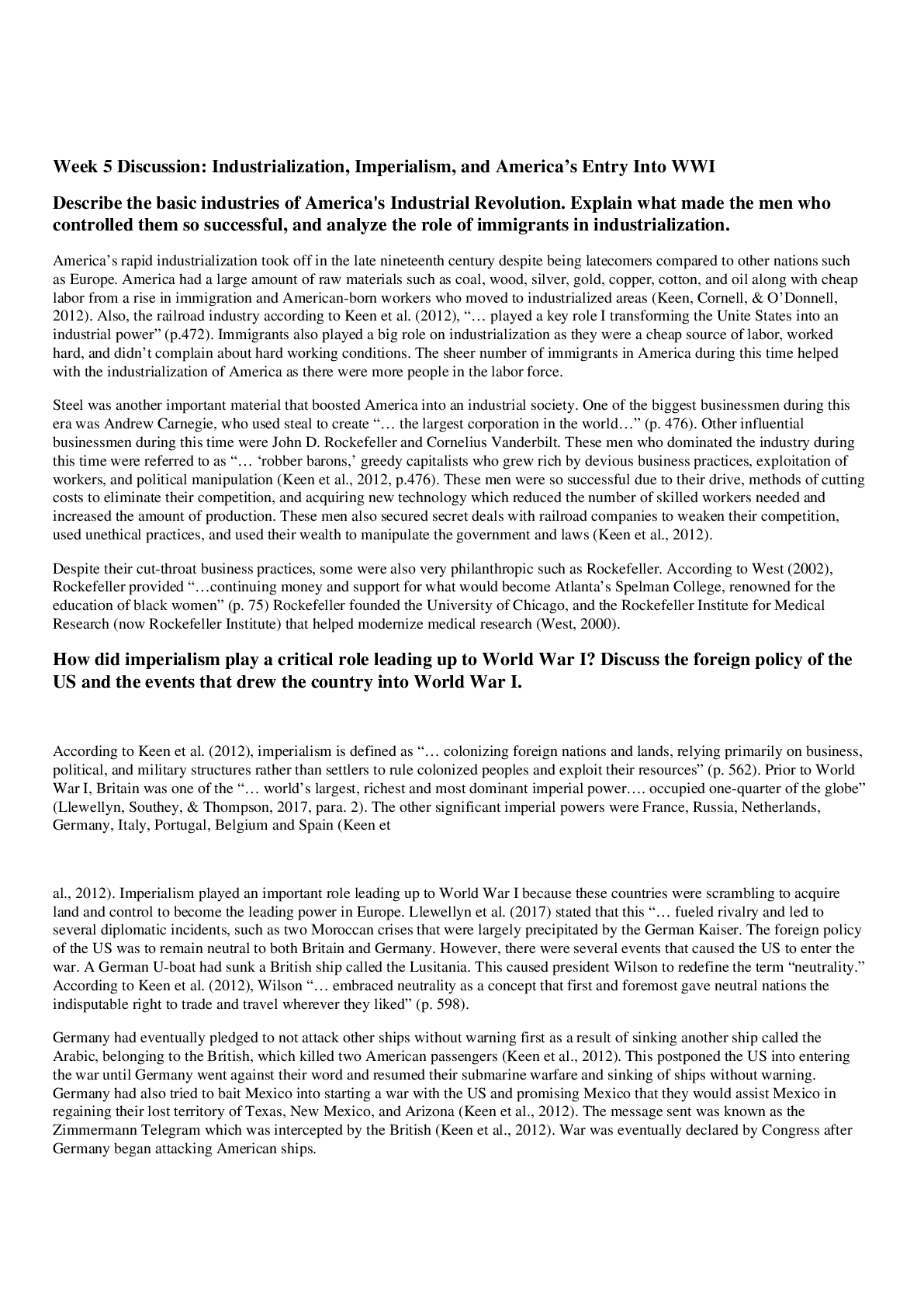
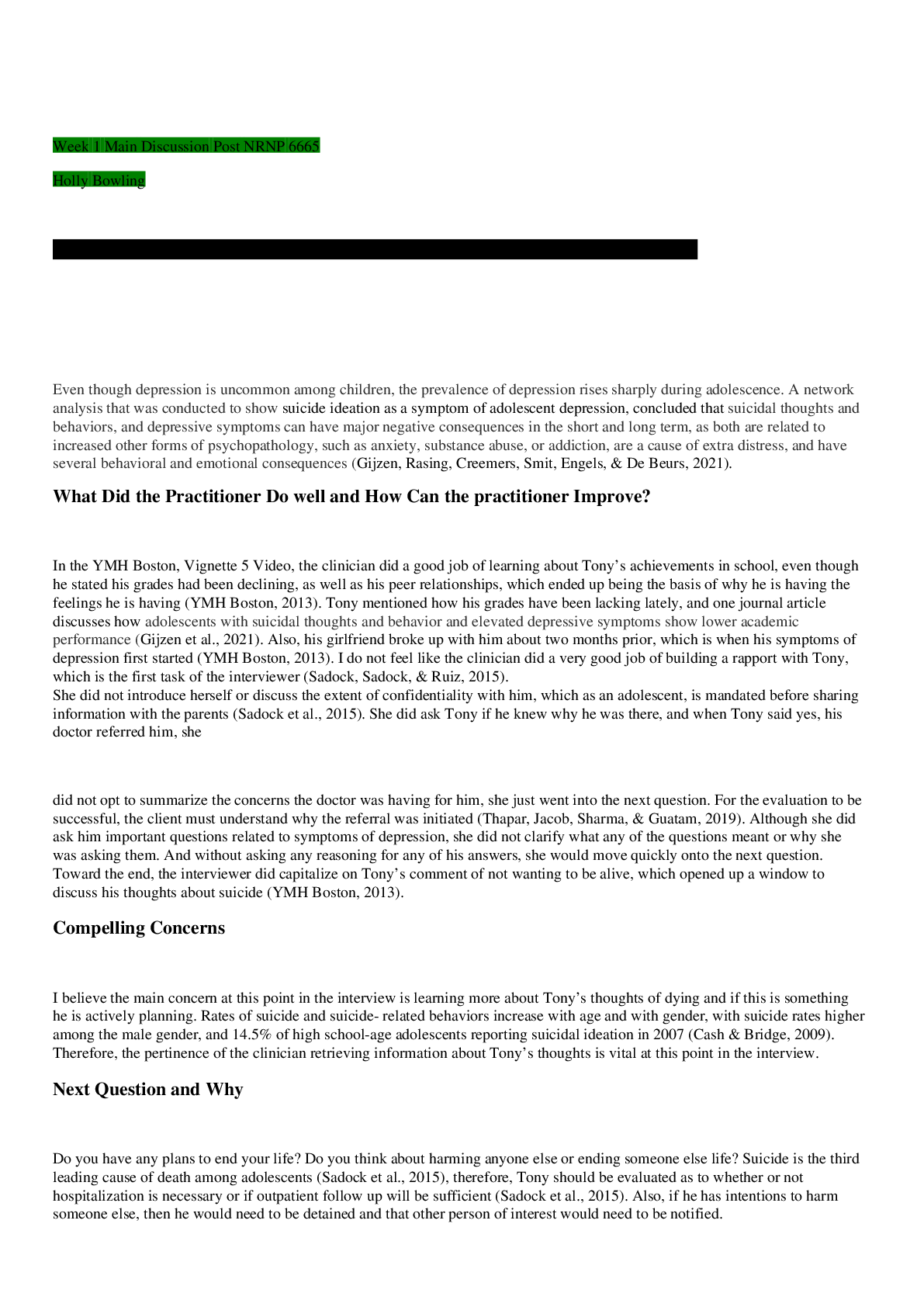

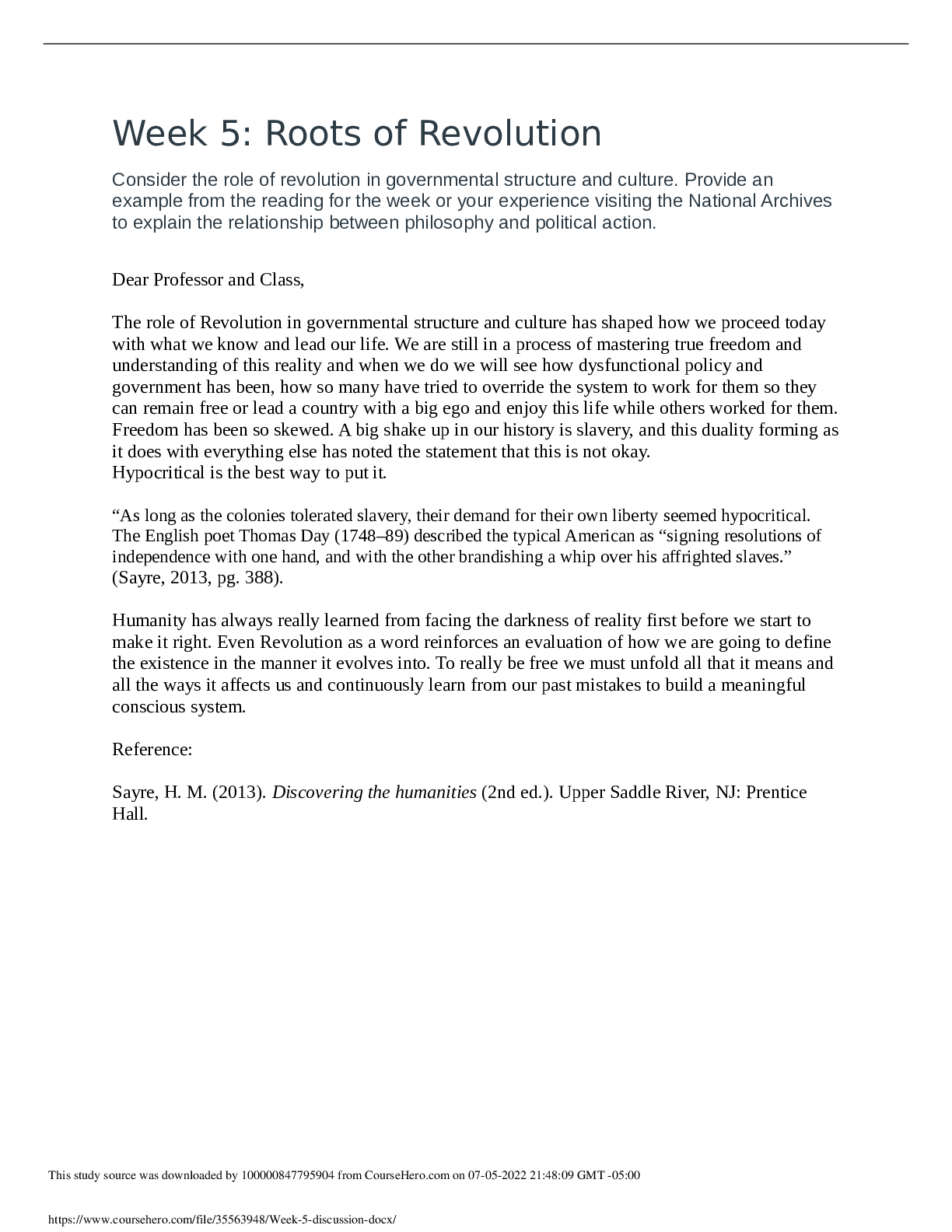
.png)
